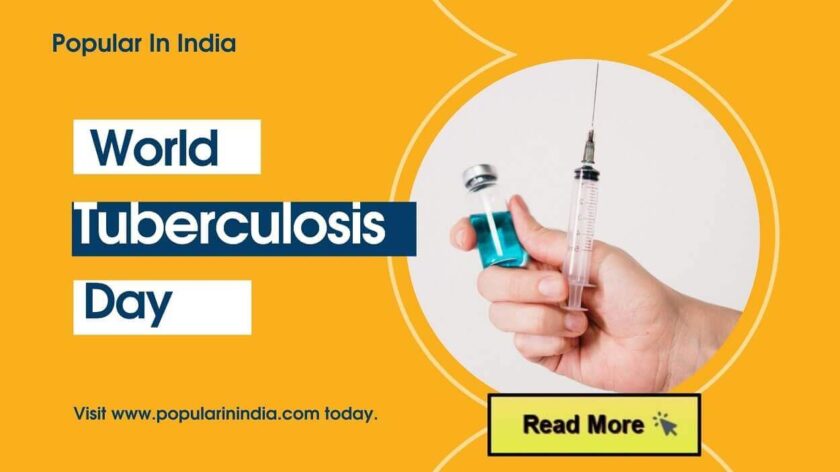World Tuberculosis Day is observed annually on March 24th to raise awareness about tuberculosis (TB) and efforts to eliminate the disease. The day is marked to commemorate the discovery of the tuberculosis bacterium by Dr. Robert Koch in 1882.
The World Health Organization (WHO) and other organizations use World TB Day to raise awareness about the impact of TB around the world, to advocate for more funding and research to combat the disease, and to promote collaboration among governments, healthcare providers, and other stakeholders to end the TB epidemic.
About Tuberculosis
Tuberculosis is an infectious disease caused by the bacteria Mycobacterium tuberculosis. It primarily affects the lungs but can also affect other parts of the body, such as the kidneys, bones, and brain. TB is spread from person to person through the air when an infected person coughs, sneezes, or talks.
History of World Tuberculosis Day
World Tuberculosis Day was first observed in 1982, to commemorate the discovery of the tuberculosis bacterium by Dr. Robert Koch on March 24, 1882. Dr. Koch’s discovery was a major breakthrough in the fight against TB, as it allowed for the development of diagnostic tests and effective treatments.
n 1996, the World Health Organization (WHO) and the International Union Against Tuberculosis and Lung Disease (IUATLD) established a working group to organize and coordinate activities for World TB Day. Since then, World TB Day has become an important event for raising awareness about tuberculosis and advocating for increased efforts to control and eliminate the disease.
Each year, World TB Day is marked by a variety of events and activities around the world, including public awareness campaigns, community outreach programs, educational seminars and conferences, and fundraising drives to support research and treatment programs. The day provides an opportunity for governments, healthcare providers, community organizations, and individuals to come together to work towards a common goal of ending the TB epidemic.
Themes of World Tuberculosis Day 2022, 2021, 2020 and 2019
Here are the themes of World Tuberculosis Day from 2019 to 2022:
- World Tuberculosis Day 2022 (March 24): “The Clock is Ticking” – This theme emphasizes the urgency of accelerating the global efforts to end tuberculosis, especially in the context of the COVID-19 pandemic.
- World Tuberculosis Day 2021 (March 24): “The Clock is Ticking” – This theme highlights the urgent need to increase efforts to end tuberculosis, especially in the context of the COVID-19 pandemic, which has disrupted TB services and worsened the TB epidemic.
- World Tuberculosis Day 2020 (March 24): “It’s Time” – This theme aimed to raise awareness about the need to accelerate the efforts to end tuberculosis, with a focus on achieving the targets set by the UN High-Level Meeting on TB in 2018.
- World Tuberculosis Day 2019 (March 24): “It’s Time” – This theme focused on the urgency of scaling up efforts to end tuberculosis, with a particular emphasis on reaching the most vulnerable and marginalized communities.
These themes reflect the ongoing global efforts to eliminate tuberculosis as a public health threat, and the need for increased attention and resources to address this urgent global health challenge.
Preventive Health Test for Tuberculosis
There are several preventive health tests available for tuberculosis, including:
- Tuberculin skin test (TST): This test involves injecting a small amount of tuberculin under the skin of the forearm and measuring the resulting bump or reaction after 48-72 hours. A positive TST indicates exposure to the tuberculosis bacteria, but it cannot differentiate between a current or past infection.
- Interferon-gamma release assays (IGRAs): This test measures the amount of interferon-gamma released by white blood cells in response to tuberculosis antigens. IGRAs are more specific than TSTs and do not cross-react with the bacillus Calmette-Guérin (BCG) vaccine.
- Chest X-ray: A chest X-ray can help detect the presence of TB in the lungs or other parts of the body.
- Sputum culture: This test involves collecting a sample of sputum (mucus coughed up from the lungs) and growing it in a lab to detect the presence of TB bacteria.
These tests can be used for both diagnosing and preventing the spread of tuberculosis. In addition to these tests, other preventive measures include vaccination with the BCG vaccine, screening high-risk populations, and providing treatment to people with latent TB infection to prevent them from developing active TB disease.
Symptoms of Tuberculosis
The symptoms of tuberculosis (TB) can vary depending on the location of the infection in the body, and whether the infection is active or latent. Some common symptoms of active TB disease include:
- Coughing that lasts for three weeks or longer.
- Chest pain.
- Coughing up blood or sputum (phlegm).
- Fatigue or weakness.
- Loss of appetite.
- Weight loss.
- Night sweats.
- Fever
TB can also affect other parts of the body, such as the kidneys, spine, or brain, and can cause additional symptoms depending on the location of the infection. In some cases, people with latent TB infection (when the bacteria are present in the body but not causing symptoms) do not have any symptoms and are unaware of the infection. However, they may develop active TB disease if the bacteria become active and multiply in the body.
It is important to note that these symptoms can also be caused by other conditions, and not everyone with TB will have all of these symptoms. If you are experiencing any of these symptoms or have been in contact with someone with TB, it is important to see a healthcare provider for testing and treatment.
Balance diet for Tuberculosis
Eating a balanced and nutritious diet can help people with tuberculosis (TB) maintain their strength, manage symptoms, and support their immune system as they undergo treatment.
Here are some tips for a balanced diet for TB:
- Eat a variety of foods: Include foods from all food groups, such as fruits, vegetables, whole grains, lean protein sources, and low-fat dairy products.
- Consume nutrient-dense foods: Choose foods that are high in nutrients such as vitamins, minerals, and fiber. Examples include leafy greens, colorful vegetables and fruits, nuts and seeds, whole grains, lean protein sources, and low-fat dairy products.
- Drink plenty of fluids: Staying hydrated is important for people with TB. Aim to drink at least 8-10 cups of water per day, as well as other fluids such as milk, herbal tea, or unsweetened fruit juice.
- Avoid processed and high-fat foods: Foods high in saturated and trans fats, as well as processed foods high in sugar and sodium, can increase inflammation and weaken the immune system.
- Eat smaller, frequent meals: Eating smaller, more frequent meals throughout the day can help maintain energy levels and prevent nausea, which is a common side effect of some TB medications.
- Get enough protein: Protein is important for maintaining muscle mass and supporting the immune system. Good sources of protein include lean meats, fish, beans, lentils, nuts, and seeds.
It is important to work with a healthcare provider and a registered dietitian to develop a personalized nutrition plan that meets the individual’s needs, as the nutritional requirements can vary depending on the stage of TB and the individual’s overall health.
People of India affected by tuberculosis
India has a high burden of tuberculosis (TB) and is one of the countries with the highest number of TB cases in the world. According to the Global Tuberculosis Report 2021, an estimated 2.6 million people in India were diagnosed with TB in 2020, which accounted for 27% of the global TB burden.
TB is a significant public health issue in India, particularly due to the high prevalence of risk factors such as malnutrition, overcrowding, and poor living conditions. The COVID-19 pandemic has also had an impact on TB diagnosis and treatment in India, with some TB cases going undetected or untreated due to disruptions in health services.
The Indian government has implemented several initiatives to address the TB burden, including the National TB Elimination Programme (NTEP) which aims to provide free diagnosis and treatment for all TB patients, and the use of digital technology to improve TB surveillance and monitoring. However, there is still a need for increased awareness, early detection, and improved access to TB care and treatment in India.



